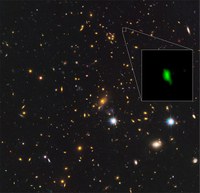The Onset of Star Formation in the Universe
A fundamental quest of modern astronomy is to locate the earliest galaxies and study how they influenced the intergalactic medium a few hundred million years after the Big Bang. The abundance of star-forming galaxies is known to decline from redshifts of about 6 to 10, but a key question is the extent of star formation at even earlier times, corresponding to the period when the first galaxies might have emerged. In this paper, Hashimoto et al. report spectroscopic observations of MACS1149-JD1, a gravitationally-lensed galaxy observed when the Universe was less than 4% of its present age. Between March 2016 and April 2017, the team performed observations of MACS1149-JD1 at the Atacama Large Millimeter/submillimeter Array (ALMA), targeting the far-infrared oxygen line, [O III] at a wavelength of 88 μm, and dust continuum emission over a broad wavelength range consistent with its photometric redshift range (z ~ 9.0–9.8). An emission line of doubly ionized oxygen was detected at a redshift of 9.1096 ± 0.0006, with an uncertainty of one standard deviation. This precisely determined redshift indicates that the red rest-frame optical color arises from a dominant stellar component that formed about 250 million years after the Big Bang, corresponding to a redshift of ~15. These results indicate that it may be possible to detect such early episodes of star formation in similar galaxies with future telescopes.
Image: The galaxy cluster MACS J1149.5+2223 as seen with the Hubble Space Telescope. The inset image is the galaxy MACS1149-JD1 observed with ALMA. The oxygen detected with ALMA is in green. Credit: ALMA (ESO/NAOJ/NRAO), NASA/ESA Hubble Space Telescope, W. Zheng (JHU), M. Postman (STScI), the CLASH Team, Hashimoto et al.
Publication: T. Hashimoto (Osaka Sangyo University, National Astronomical Observatory of Japan) et al., The onset of star formation 250 million years after the Big Bang, Nature (17 May 2018).





Connect with NRAO